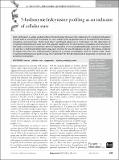Files in this item
5-hydroxymethylcytosine profiling as an indicator of cellular state
Item metadata
| dc.contributor.author | Laird, Alexander | |
| dc.contributor.author | Thomson, John P. | |
| dc.contributor.author | Harrison, David J. | |
| dc.contributor.author | Meehan, Richard R. | |
| dc.date.accessioned | 2014-08-14T14:01:01Z | |
| dc.date.available | 2014-08-14T14:01:01Z | |
| dc.date.issued | 2013-12 | |
| dc.identifier | 136160997 | |
| dc.identifier | 7548c8bd-b9a6-4679-abbd-ff61551a7832 | |
| dc.identifier | 000327470700010 | |
| dc.identifier | 84889646827 | |
| dc.identifier.citation | Laird , A , Thomson , J P , Harrison , D J & Meehan , R R 2013 , ' 5-hydroxymethylcytosine profiling as an indicator of cellular state ' , Epigenomics , vol. 5 , no. 6 , pp. 655-669 . https://doi.org/10.2217/epi.13.69 | en |
| dc.identifier.issn | 1750-1911 | |
| dc.identifier.other | ORCID: /0000-0001-9041-9988/work/64034229 | |
| dc.identifier.uri | https://hdl.handle.net/10023/5157 | |
| dc.description | A Laird is supported by the Medical Research Council Scottish Clinical Pharmacology and Pathology Programme, The Royal College of Surgeons of Edinburgh Robertson’s Trust and The Melville Trust for the Care and Cure of Cancer. J Thomson is supported by the MARCAR project. Work in RR Meehan’s laboratory is supported by the Medical Research Council, the BBSRC and by the Innovative Medicine Initiative Joint Undertaking (IMI JU) under grant agreement number 115001 (MARCAR project). | en |
| dc.description.abstract | DNA methylation is widely studied in the context of cancer. However, the rediscovery of 5-hydroxymethylation of DNA adds a new layer of complexity to understanding the epigenetic basis of development and disease, including carcinogenesis. There have been significant advances in techniques for the detection of 5-hydroxymethylcytosine and, with this, greater insight into the distribution, regulation and function of this mark, which are reviewed here. Better understanding of the associated pathways involved in regulation of, and by, 5-hydroxymethylcytosine may give promise to new therapeutic targets. We discuss evidence to support the view of 5-hydroxymethylcytosine as a unique and dynamic mark of cellular state. These 5-hydroxymethylcytosine profiles may offer optimism for the development of diagnostic, prognostic and predictive biomarkers. | |
| dc.format.extent | 15 | |
| dc.format.extent | 3162265 | |
| dc.language.iso | eng | |
| dc.relation.ispartof | Epigenomics | en |
| dc.subject | Cancer | en |
| dc.subject | Cellular state | en |
| dc.subject | Epigenetics | en |
| dc.subject | Hydroxymethylcytosine | en |
| dc.subject | Embryonic stem-cells | en |
| dc.subject | Active DNA demethylation | en |
| dc.subject | Acetylglucosamine transferase OGT | en |
| dc.subject | Isocitrate dehydrogenase 1 | en |
| dc.subject | Acute myeloid-leukemia | en |
| dc.subject | Base excision-repair | en |
| dc.subject | Mouse-liver tumors | en |
| dc.subject | TET proteins | en |
| dc.subject | Thymine DNA | en |
| dc.subject | Human cancers | en |
| dc.subject | RC0254 Neoplasms. Tumors. Oncology (including Cancer) | en |
| dc.subject | QH426 Genetics | en |
| dc.subject | SDG 3 - Good Health and Well-being | en |
| dc.subject.lcc | RC0254 | en |
| dc.subject.lcc | QH426 | en |
| dc.title | 5-hydroxymethylcytosine profiling as an indicator of cellular state | en |
| dc.type | Journal article | en |
| dc.contributor.institution | University of St Andrews. School of Medicine | en |
| dc.identifier.doi | https://doi.org/10.2217/epi.13.69 | |
| dc.description.status | Peer reviewed | en |
This item appears in the following Collection(s)
Items in the St Andrews Research Repository are protected by copyright, with all rights reserved, unless otherwise indicated.

